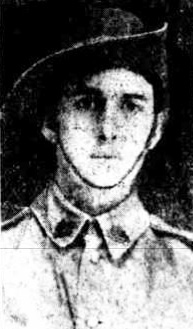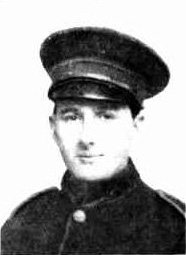William Charles Woodland
From Our Contribution
 | |
 Western Mail 3 Aug 1917 page 19 | |
| Personal Information | |
|---|---|
| Date of Birth |
not known "not known" contains an extrinsic dash or other characters that are invalid for a date interpretation. |
| Place of Birth | Perth, Western Australia |
| Death | 17 Dec 1978 |
| Place of Death | Applecross, Western Australia |
| Age at Enlistment | 18 years, 11 months |
| Description |
5'9" (1.75m) tall ; 1215 lbs 551.114 kg ; fresh complexion ; brown eyes ; dark hair |
| Occupation | Mill hand |
| Religion | Church of England |
| Address | No 1 Mill, Jarrahdale, Western Australia |
| Next of Kin | Father , Mr Edwin Portman Woodland |
| Military Information | |
| Reg Number | 4013 |
| Date of Enlistment | 26 Aug 1915 |
| Rank | Private |
| Unit/Formation | 11th Battalion, 12th Reinforcement transferred to 51st Battalion, 16 Platoon, D Comany / 13th Brigade, 4th Division |
| Date of Embarkation | 22 Nov 1915 ‒ 14 Dec 1915 |
| Ship Embarked On | RMS Mongolia |
| Date of Return | 23 Sep 1918 ‒ 17 Nov 1918 |
| Ship Returned On | HMAT A54 Runic |
| Fate |
Prisoner of War 3 Sep 1916 Mouquet Farm Returned to Australia |
| Monument |
Jarrahdale Honour Roll ANZAC Memorial Park (Byford) |
| Medals |
1914-15 Star British War Medal Victory Medal |
Pre War
War Service
Transferred from the 11th Battalion at Serapeum, Egypt to the 51st Battalion at Habiera on 2 Mar 1916. On 23 Apr 1916 he was struck off strength of the battalion for being medically unfit and admitted to the 3rd Australian Auxiliary Hospital in Abbassia before transferring to the Convalescent Depot on 1 May 1916. He returned to duty in Egypt on 29 May 1916.
In England he was sent to the 13th Training Battalion at Rollestone before on 22 Jul 1916 proceeding overseas to France. Taken on strength by the 51st Battalion again on 21 Aug 1916, one of 109 reinforcements that they absorbed in Bonneville on that day. Bonneville is a small hamlet, well behind the front lines at that time where units could rebuild and repair after being in front line trenches.
As soon as they were settled they were back into the front lines near Poziéres, and on 1 Sep 1916 were tasked with replacing the 47th Battalion in the Mouquet Farm Sector early in the morning of the 2nd. Early the next morning they launched an attack along with the 52nd Battalion on the farm itself. While they were able to reach the farm proper, their flanks were unprotected, there were extensive underground workings hiding German troops who had not been mopped up and then the enemy opened up with a very heavy artillery bombardment on the farm itself at 9:30am. By 10:30am B and D Companies, or those that remained, were cut off and while some escaped, their ability to carry wounded back to their start point was heavily compromised. Bill reports that he and others were able to wait it out in a dugout for five days before they were captured by the Germans.
Initially posted as missing, it was later discovered that Bill had been wounded in the right upper arm (fractured Humerus)and lower jaw (throat), before being captured by the Germans on 8 Sep 1916. Official date for capture is still given as 3 Sep 1916. On 27 Sep 1916 he was in a German Lazaretto in Caudry, south east of Cambrai. [1].
Prior to his capture Bill had received a bullet wound to his throat and a bomb splinter to his shoulder that passed right through the socket of the shoulder. Any use pf the arm caused the wound to discharge and his arm would swell up.
Transferred to Switzerland on 27 Dec 1917 (Only soldiers who it was though could never bear arms again were repatriated to either Holland or Switzerland, from where they could be returned to their homeland for medical attention.
From Switzerland, Bill wrote to the Australian Military HQ in London from Hotel Mont Blanc, Leysin, Switzerland on 18 Jan 1918 seeking a uniform for himself and four other Australians who have only black working clothes form Germany in poor condition. They sought a uniform of 'Australian' cut. While in Switzerland, he was awarded 4 days in cells by the British OC Internment, for being found drunk in a café in Leysin.
Repatriated to England on 14 Jun 1918, and admitted to King George Hospital for treatment to his injuries. It was discovered that he had also, during his time as a prisoner, developed Fibrosis of the Lungs.
STATEMENT BY REPATRIATED PRISONER OF WARReg No 4013 Rank Pte WOODLAND W.C.
CIRCUMSTANCES OF CAPTURE (a) Date 3rd September 1916 (b) Place Mouquet Farm (Somme)
What happened immediately before capture On the 3rd September 1916, the 4th Division launched an attack on Mouquet Farm. The object was I think to capture a strong line of trenches just in front of Mouquet Farm.
The previous night the 51st filed out of a communication trench to the "Jump-off Line which had been marked out for us previously. We lay there until about 5.10 a.m. when we got the order to advance. "Fritz" put up a very heavy barrage on our right and the 52nd Battalion who were to have supported us on that flank were subsequently delayed in their attack. We reached the enemy first line and captured it after a sharp struggle and then passed over on to his second line and proceeded to bomb the Germans out. After a very stiff fight we drove him out and took possession. We remained in possession until about noon when the enemy counter attacked. A number of our men with an officer got down into a dug out and must have retired through another entrance. Myself and 15 other men did not get any orders so we fought on and in about half an hour we were all knocked out and only three of us remained alive.
I was wounded through the throat by a rifle bullet and by the "whiz-bang" in the shoulder. Pte Pilgrim and Pte Callow were both badly wounded and Pte Torboy was shot through the stomach and died. We crawled into the dug-out and remained there for five days before being picked up by the Germans. There was one wounded German with us.
Officers seen During Engagement I saw the following Officers during the action:- Lieut Bailey - he was wounded in the head. Lieut D. Campbell, - he was off to my right. I saw both these officers in the German trenches and one other officer whose name I don' know. The later it was who retired through the dug-out.
What happened Immediately after Capture From the dug-out we were taken to a dressing station in the German trenches and our wounds dressed. Two hours later we were moved by horse ambulance to a small village behind Mouquet Farm. I was left there in a tent for two days and was then moved to Caudry travelling by train. There I was placed in hospital, where an operation was performed on my shoulder. There I saw:- 2124 Cpl Drummond J. 51st Bn 1761 Sgt Read A.E. 51st Bn (Deceased) 2010 Sgt Ramshaw 51st Bn since repatriated 3003 Cpl Maxwell E.H. 51st Bn since repatriated 1756 Pte Morley E. 51st Bn 4565 Pte McGuire D. 51st Bn repatriated 14 Jun 1918
All these men were wounded. I think that Sergt Read died here. He was in a very bad way.
Long Spell in Darmstadt
I remained at Caudry for two weeks and was then moved to Darmstadt in Germany and placed in hospital where I remained for seven months and received good medical treatment but bad and insufficient food.
From there I was moved to Giessen remaining there for a month before being sent out to work at Frankfurt, where I was put at light work in a tannery. Shortly after I was moved to a coal yard where the work was very hard and later was put at unloading trucks of wood. Then again I was put on light work in a Military provision store. I got sick here and was sent back to Giessen where I passed the Commission for internment in a neutral country. I was the only Australian in my party. While at the tannery the food issue was good, but at the other places it was not fit to eat.
My Red cross parcels arrived during February 1917, while I was at Giessen, afterwards coming regularly. We relied on them absolutely for food. I don't believe I should have lived without them. The soap and tobacco were often missing from them, but otherwise everything was alright.
Our Airman's Xmas Gift to Mannheim From Giessen I was sent to Mannheim arriving there on 8th December 1917. While there I witnessed the Christmas Eve Air raid by our airmen. There were a number of machines and they did a considerable amount of damage practically destroying the Ammunition factory, damaging the gas works and railway and a lot of other damage.
Internment in Switzerland I arrived in Switzerland on the 28th of December 1917, and went to Leysin staying at the Hotel Mont Blanc. The treatment here was good also the food and accommodation. All the Australians I knew there came to England with me.
We left Switzerland on the 11th June 1918, journeyed through France by Ambulance train to le Havre and arrived in England on the 14th June 1918. We were all taken to King George Hospital at Waterloo. There were 27 of us in the party that had arrived from Switzerland.
On 22 Jul 1918 Bill married Annie Barnes of Wealdstone in Harroweald, England while undergoing rehabilitation.
Back in Fremantle he was admitted to the 8th Australian General Hospital where he was AWOL on three occasions while in hospital being admonished each time and forfeiting a total of five day's pay. One of the AWOL periods was from 4:30pm 24 Dec until 6:30pm 26 Dec 1918.
Discharged by 5th Military District on 31 May 1919.
Post War
Electoral Roll entries - 1922 - 1935 Mundijong, mill hand; 1936 - 1954 at 65 Hampshire street, Victoria Park, no occupation; 1958 - 1968 at 37 Birdwood street, North Innaloo; 1972 Bill only at 62 Gwenyfred road, Kensington;
Notes
- ↑ "Australian Red Cross Wounded and Missing Files - William Charles Woodland". Australian War Memorial. 2018. Retrieved 2 May 2018.